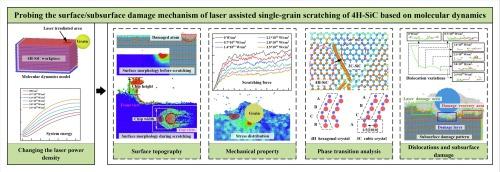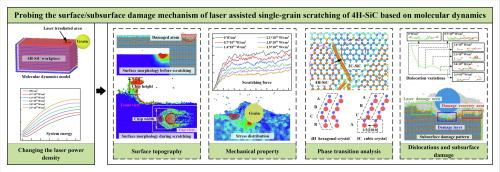Probing the surface/subsurface damage mechanism of laser assisted single-grain scratching of 4H-SiC based on molecular dynamics
IF 6.9
2区 材料科学
Q2 CHEMISTRY, PHYSICAL
引用次数: 0
Abstract
SiC exhibits tremendous potential for semiconductors and microelectronics applications due to its excellent attributes. 4H-SiC is a difficult-to-machine material owing to its unique anisotropy, high hardness, and high brittleness. 4H-SiC is generally processed by grinding, but the material removal efficiency is low, and there are machining defects on the surface. Laser assisted grinding can enhance both the efficiency of processing and the quality of surfaces. However, the mechanism of material removal and damage by laser action on 4H-SiC remains ambiguous, so this paper utilizes the method of molecular dynamics to explore the surface/subsurface damage mechanism of laser assisted single-grain scratching of 4H-SiC crystals and systematically investigates the effects of laser power on the material damage, scratch force, stress, chip morphology, dislocations, and subsurface damage to probe the material removal mechanism of the scratching process. The results demonstrate that as the laser’s intensity rises, the scratching force and stress decrease, and the depth of subsurface damage diminishes. Transformations of 4H-SiC into the more stable 3C-SiC crystal form were found near the incomplete dislocation lines at high power densities. This study reveals the intrinsic mechanism of laser assisted grinding processing of 4H-SiC and provides theoretical guidance for laser assisted grinding processing.


基于分子动力学的激光辅助4H-SiC单晶粒划痕表面/亚表面损伤机理研究
碳化硅以其优异的性能在半导体和微电子领域显示出巨大的应用潜力。由于其独特的各向异性、高硬度和高脆性,4H-SiC是一种难以加工的材料。4H-SiC一般采用磨削加工,但材料去除效率低,且表面存在加工缺陷。激光辅助磨削既能提高加工效率,又能提高表面质量。然而,激光作用于4H-SiC的材料去除和损伤机理尚不明确,因此本文利用分子动力学方法探索激光辅助4H-SiC晶体单粒刻划的表面/亚表面损伤机理,系统研究激光功率对材料损伤、划痕力、应力、切块形貌、位错和亚表面损伤的影响,探讨刻划过程的材料去除机理。结果表明:随着激光强度的增大,刻划力和刻划应力减小,亚表面损伤深度减小;在高功率密度下,在不完全位错线附近发现了4H-SiC向更稳定的3C-SiC晶体形式的转变。本研究揭示了激光辅助磨削加工4H-SiC的内在机理,为激光辅助磨削加工提供了理论指导。
本文章由计算机程序翻译,如有差异,请以英文原文为准。
求助全文
约1分钟内获得全文
求助全文
来源期刊

Applied Surface Science
工程技术-材料科学:膜
CiteScore
12.50
自引率
7.50%
发文量
3393
审稿时长
67 days
期刊介绍:
Applied Surface Science covers topics contributing to a better understanding of surfaces, interfaces, nanostructures and their applications. The journal is concerned with scientific research on the atomic and molecular level of material properties determined with specific surface analytical techniques and/or computational methods, as well as the processing of such structures.
 求助内容:
求助内容: 应助结果提醒方式:
应助结果提醒方式:


